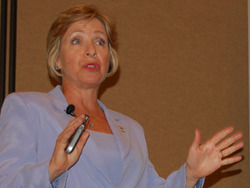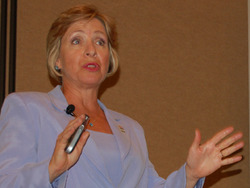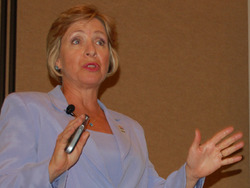


This is the first of three articles designed to compel you to start putting the point back in PowerPoint. Here you will discover my first four pointers and why you need an Xtreme PowerPoint Makeover. Stop using PowerPoint as a delivery mechanism! It is a support media for your message.
You Deliver the Message
Get one thing straight. Humans are multi-channel processors. We can look at one thing. We hear an elaboration. We learn more by doing than if we read it all. That’s why you learned to write your letters with fingerpaints while copying what was on the chalkboard (I’m dating myself and possibly you) and listening to what your teacher was saying. If your teacher tried to teach you your letters and numbers by only PowerPoint, you’d still be in kindergarten! Learning happens all over the body. It is not limited to lecture. Learning is molecular. Time after time, training programs are only content-centered. Here are a few “point”ers on what not to do in a training session.
12. Don’t Use Your Slides as Your Handout
A boring and ill-conceived idea that gets repeated in training sessions across the country. Your slides are the headline to your verbal elaboration. The only exception could be extremely complex technical material I am seeing for the first time. Even then, at the very least, have two slide decks. One slide deck is complete and projected from the front of the room. The other has key words and concepts that are left blank. Make a handout based on this second deck so trainees can fill in the blanks as slides are revealed. Sleep learning doesn’t work, involvement does.
11. Don’t “You” Read the Slides
Change it up. Don’t say what is on the slide; have your audience tell you. Have your points numbered 1-10 and distribute the cards 1-10 throughout your audience and invite them to read and explain that point. Instead of reading the slide, just elaborate on the bold point your slide makes (which is large enough everyone can read it). Project a chart and ask the small groups to discuss and be prepared to tell you what it means. Your slides are your support, not your message.
10. Narrate a Story, Use Headlines on Slides
Decide where you want your audience to be after your presentation or training and decide where they are now. Narrate an interesting story that takes them from where we are to where we want to be. Let the slides be your headlines and you tell the story.
9. Use a Headline and Graphic on Every Slide.
Take advantage of the multi-media feature of PowerPoint and our brains. Support the words with a graphic or picture that make them come alive. Rather than words to tell about the majestic mountains and tangled trees in your wonderland, show them. Since we remember better and recall pictures faster, graphic images assist retention and recall.
For article two of "Purposeful PowerPoint® Pointers," click here!
For article three of "Purposeful PowerPoint® Pointers," click here!
Betsy Allen was senior vice president at the Bob Pike Group and is co-author with Bob Pike of Powerful Presentations, Volume 1: 39 Quick Openers, Puzzlers and Energizers that Spark Interest and Focus Your Topic.
This article was re-uploaded from our internal archive.
Don't miss out on updates and chances
to sharpen your skills with participant-centered learning.




3740 N Chestnut St #113 - Chaska, MN 55318-3053